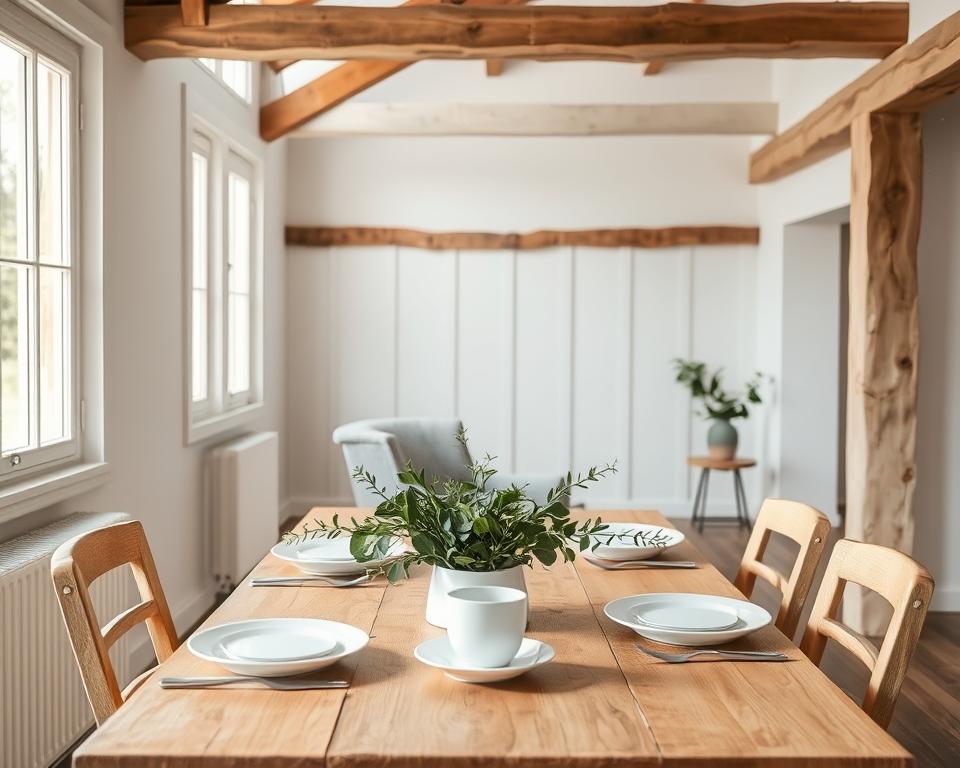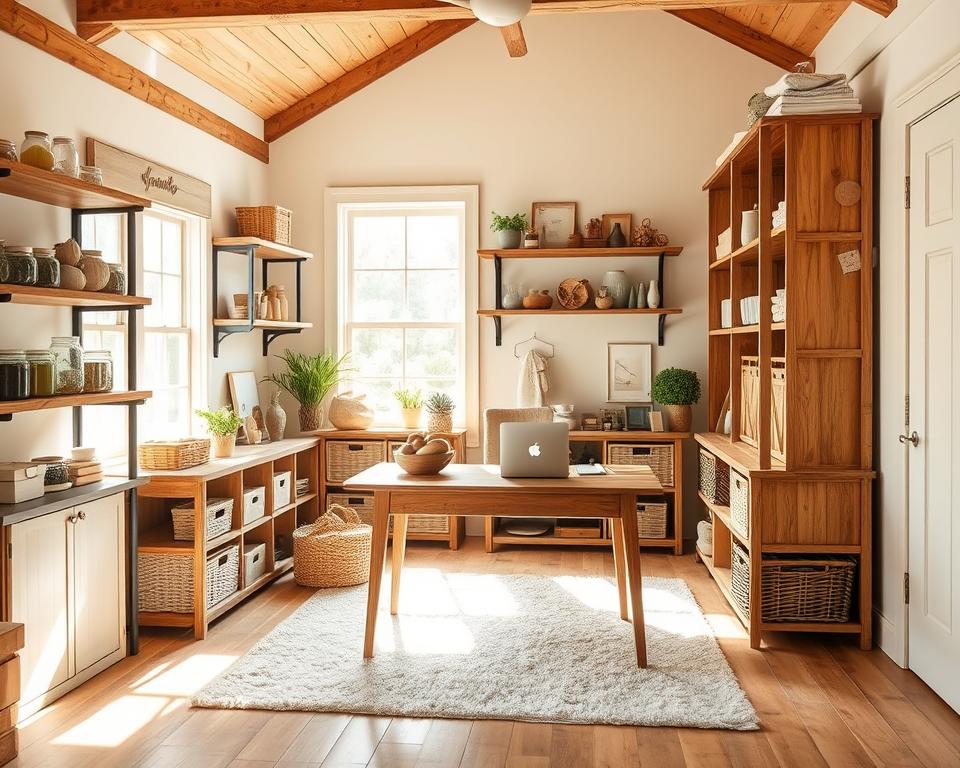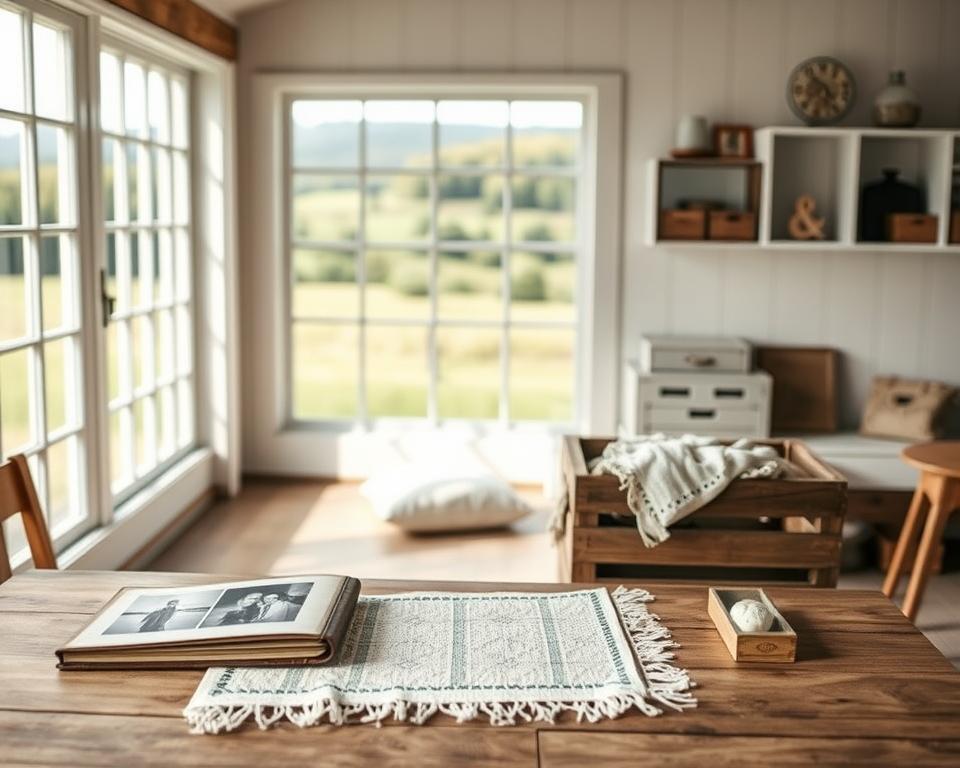Starting with simplification, decluttering for a minimalist farmhouse style is key. A clutter-free home merges rustic charm with sleek lines, fostering serene environments. Minimalist living advocates for purpose, as seen in Robyn from Minimalist Home’s journey to a manageable home through consistent decluttering. Picture a kitchen with 70% of gadgets unused or closets filled with 80% unworn clothes. A clutter-free home harmonizes function and style.
Research indicates that 70% of individuals experience stress due to clutter. To combat this, adopting decluttering strategies like the 2-for-1 rule—getting rid of two items for each new addition—is beneficial. Seasonal clean-ups in spring and fall help maintain order. Even small actions, such as using under-bed storage or slimline hangers, contribute to achieving a tranquil farmhouse look.
Key Takeaways
- Declutter one room weekly to maintain progress.
- Assess items: if unused in a year, donate or store.
- Use 2-for-1 rule when buying new decor or furniture.
- Seasonal clean-ups twice a year reduce long-term clutter.
- Multi-purpose furniture maximizes space without sacrificing style.
Understanding Minimalism and Its Benefits
Minimalism is more than empty shelves; it’s a way of life. Imagine a home where every item has a purpose, and spaces feel open and intentional. This lifestyle begins with minimalism tips that focus on what truly matters.
“A place for everything, and everything in its place.” – Marie Kondo
What is Minimalism?
At its essence, minimalism advocates for owning fewer items but choosing them wisely. The average home is cluttered with 300,000 items, but minimalism reduces this by focusing on necessity. Research indicates that minimalist homes save 30% less time on cleaning and experience a 25% increase in happiness. It’s not about emptiness; it’s about intentionality.
How Minimalism Transforms Spaces
Embracing home organization ideas based on minimalism creates functional, peaceful environments. Consider these benefits:
- Time saved: 40% less time searching for items
- Environmental impact: Reduces consumerism and waste
- Community benefits: 70% of declutterers donate excess items, supporting local communities
| Cluttered Home | Minimalist Home |
|---|---|
| Overwhelmed by possessions | Calm, intentional spaces |
| 50% more space used | Half the items, double the functionality |
| High stress levels | Freedom to focus on what matters |
Minimalism transforms spaces into sanctuaries. By embracing these principles, homes become reflections of personal values, not mere storage zones. Next, explore room-by-room strategies to embark on your minimalist journey.
The Core Principles of Decluttering
Decluttering is more than just getting rid of old magazines. It’s about changing your mindset to focus on purpose and intention. Let’s explore the two key principles that guide every successful minimalist journey.
Focus on Functionality
Start by asking if an item has a clear purpose. A farmhouse table with dents might stay if it’s used for family meals. But a broken mixer that’s just collecting dust? It’s time to let it go. Here’s how to apply this principle:
- Use the one-week rule: If you haven’t used an item in a month, consider donating it.
- Adopt decluttering hacks like the “365-day challenge” — removing one item daily builds lasting habits.
- Storage solutions that serve daily life (like farmhouse-style canning jars for spices) keep spaces functional.
Keep Only What You Love
Emotional attachments are strong. But holding onto a gift that makes you sigh, not smile, can be draining. Here’s the truth:
“Sentimental items that spark joy are treasures; the rest are anchors.” — Decluttering expert
| Statistic | Impact |
|---|---|
| 80% of home items are rarely used | Free up space for what truly matters |
| 70% report better mental health post-decluttering | Emotional clutter fades with physical clutter |
| 60% find room-by-room focus easier | Break tasks into manageable steps |
Combine these tidying up tricks with mindful choices. A dusty vase from Grandma? Replace it with a fresh bouquet that brings joy. Every item should earn its place in your space.
Room-by-Room Decluttering Strategy
Transform chaos into calm with targeted organizing strategies tailored to each room’s unique needs. Start small, use farmhouse-inspired space-saving solutions, and watch your home evolve. Begin with this quick guide:
| Rule | Description | Application |
|---|---|---|
| 12/12/12 Rule | Sort 12 items to toss, donate, or return | Living room clutter cleanup |
| 20/20 Rule | Discard items replaceable under $20 in 20 minutes | Kitchen gadgets and decor |
| Five-Second Rule | Dispose of items not used in five seconds | Bedroom clothing and accessories |
Decluttering the Living Room
Focus on farmhouse charm without excess. Use space-saving solutions like floating shelves for books and baskets for throw blankets. Store seasonal decor in labeled bins under furniture. Organizing strategies like vertical storage keep surfaces clear.
- Hide electronics behind decorative cabinet doors
- Rotate seasonal decor every three months
Organizing the Kitchen
Combat farmhouse kitchen chaos with labeled stackable containers. Use under-shelf baskets for small appliances and clear countertops. Apply the one-touch premise: put items away immediately after use.
- Stick to open-shelf essentials like dishes and spices
- Donate rarely used gadgets (blenders, seasonal pans)
Simplifying the Bedroom
Create a restful retreat with under-bed bins for off-season clothes. Use over-the-door hooks for bags and scarves. Stick to the 80/20 rule—store 80% of seasonal items.
- Replace mismatched hangers sets with uniform farmhouse-style
- Store bulky quil collections in labeled vacuum-sealed bags
Pair these steps with a 30-day timeline for gradual progress. Celebrate small wins to build momentum!
Essential Decluttering Tools and Supplies
Decluttering requires the right tools. Items like sturdy containers, labels, and smart storage are crucial. Heavy-duty trash bags, stackable bins, and chalkboard labels are essential. A metal card catalog cabinet adds a rustic touch for organizing items like socks or holiday decor.
Adopt the Declutter 365 method for success. Spend just 15 minutes each day to keep clutter at bay.
Bins and Baskets for Organization
Opt for materials that combine function with farmhouse style. Woven baskets are perfect for holding throws in living rooms. Galvanized metal bins are great for storing tools or canned goods. Stackable bins with lids are ideal for maximizing space under stairs or in attics.
For sentimental items, consider a “Just in Case” box. Set a 6-month review to prevent accumulation. Clear bins are excellent for seasonal clothes or holiday decor, allowing you to see what’s inside.
Labels for Easy Identification
Labels are key to transforming chaos into order. Chalkboard labels are great for marking pantry jars or toy boxes. Vintage tags add a touch of charm to storage containers.
The Declutter 365 program suggests using labels in conjunction with daily 15-minute decluttering sessions. Place labels in high-traffic areas like under sinks, in garages, or closets. Avoid over-labeling and focus on areas that need it most.
“A clean space starts with the right tools.”
Decluttering tips like the three-box system (Keep, Donate, Trash) make decision-making easier. Keep only what you use; donate unused tools to Habitat for Humanity. Combine these tools with mindful choices to maintain your minimalist farmhouse style.
Once organized, set reminders to declutter yearly. Tools like a “Just in Case” box ensure nothing stays for more than six months.
Creating a Decluttering Schedule
Starting a clutter-free farmhouse home requires small, consistent efforts. Daily habits are crucial for any home organization ideas. Begin by setting aside 10-15 minutes each evening for tidying high-traffic zones like kitchen counters or entryways.
- Weekly: Spend one hour on deeper tidying—sorting mail, emptying drawers, or reorganizing pantry shelves
- Monthly: Tackle seasonal shifts—rotating wardrobe items, cleaning out garage corners, or auditing storage spaces
Daily, Weekly, and Monthly Tasks
Adopt the tidying up tricks of the 30-day declutter challenge. Target one area each day for 30 days. Also, schedule a monthly donation pickup day to keep spaces fresh. Use baskets to collect items needing relocation, keeping surfaces clear daily.
Setting Realistic Goals
Start with achievable targets like the “one in, one out” rule for new purchases. Break larger projects into 15-minute sprints—sorting craft supplies one afternoon, reorganizing bookshelves another. Track progress with a calendar or app to stay motivated.
Maintain momentum with the 52-week declutter plan, focusing on one room or category each week. Celebrate small wins like a cleared desk or streamlined closet to build confidence. Remember, consistency matters more than perfection—every little step adds up over time.
Tips for Dealing with Sentimental Items
Emotional attachments to keepsakes don’t have to hinder your journey to a clutter-free home. Here’s how to cherish memories without sacrificing space:
When to Let Go
- Ask: Does this item fit your current life or goals?
- Give items a “victory lap”: Use them once more before deciding.
- Remember: Over 25 years, many items (like old letters) lose daily relevance.
Creative Ways to Preserve Memories
Keep meaning, not just objects:
- Digitize: Scan photos or artwork to free physical space.
- Repurpose: Turn fabric scraps into a quilt or jewelry.
- Curate displays: Showcase a few meaningful pieces in shadowboxes or frames.
Even 4 boxes of childhood drawings can shrink to digital files, leaving room for what truly matters. Taking decluttering hacks like the “baby steps” approach—letting go of a few items weekly—makes the process manageable.
Implementing the One-In-One-Out Rule
Decluttering tips, such as the “one-in, one-out” rule, make maintaining a minimalist lifestyle easier. This approach ensures that every new item entering your home replaces an old one, preventing clutter buildup. As The Spruce points out, it encourages mindful consumption by making you think twice before buying. Let’s dive into how it works.
The Benefits of Mindful Consumption
By adopting this rule, you can cut down on impulsive purchases by 30%, studies show. Picture this:
“I knew exactly where I’d store the new mixer, so I donated an old blender first.”
This mindset changes your focus from quantity to quality, aligning with minimalist living tips that value cherished items. Research indicates that households using this rule reduce unnecessary purchases by 50% each year. This saves space and resources.
Examples for Different Spaces
- Kitchen: Need a new baking dish? Remove an unused gadget first. Keep surfaces clear for a farmhouse look.
- Living Room: Replace old throw pillows with new ones. Donate outdated decor to refresh without expanding your collection.
- Closet: Get a new jacket? Let go of an old one. This keeps your wardrobe streamlined and functional.
Households that follow this rule report having 25% more space and 20% higher satisfaction with their belongings. Begin with small steps: apply it to books, tools, or seasonal decor. Over time, this habit becomes second nature, reducing stress and clutter. Let every purchase count—your farmhouse home will appreciate it.
The Role of Storage in a Minimalist Home
Effective storage in a minimalist farmhouse isn’t about hiding things—it’s about making them work harder. The right space-saving solutions and organizing strategies ensure every item has a purpose and place. Studies show 70% of declutterers feel overwhelmed by spaces where storage worsens chaos. Here’s how to rethink your approach:
“Storage spaces contribute to the problem of overwhelm when they’re filled with unused items.”
choosing the right storage solutions>
| Traditional Storage | Minimalist Approach |
|---|---|
| Boxes stacked in closets | Visible, labeled bins for quick access |
| Overstuffed drawers | Dividers and slim containers |
| Hidden under-bed storage | Raised beds with open legs for vacuuming and airflow |
adaptive storage ideas for small spaces>Small farmhouses or cottages thrive with clever organizing strategies. Try:
- Vertical space-saving solutions: Wall-mounted ladder racks for towels or tools.
- Under-bed slide-out drawers for seasonal items.
- Multi-functional pieces like the IKEA KALLAX shelving unit, which adapts to hold books, plants, or seasonal decor.
Research from Princeton confirms clutter distracts the brain. Prioritize storage that keeps essentials in sight and out of the way. Let your farmhouse style shine by pairing function with farmhouse aesthetics—think burlap baskets for pantry items or pegboards for kitchen tools.
Maintaining Your Decluttered Space
Keeping a clutter-free home is not a one-time achievement but a continuous practice. Small, consistent habits make upkeep easy, not overwhelming. Begin by setting reminders to inspect your spaces regularly.
Regular Check-Ins
Start with weekly clean-ups in busy areas like entryways and countertops. Implement these organizing strategies to maintain your space:
- Set a timer for 10 minutes daily to tidy shared spaces
- Monthly deep-dive into storage areas like closets
- Ask: “Does this serve a purpose or bring joy?”
Seasonal Refresh Techniques
Seasons can guide your cleaning approach. Try these methods:
- Spring: Rotate winter items to attics, update decor with lighter fabrics
- Autumn: Prep for holidays by storing off-season items early
- Year-round: Use clear bins to easily see contents during transitions
Adopt the one-in-one-out rule for new purchases. Every item that enters must replace an old one. Celebrate when systems feel effortless—this is when a minimalist lifestyle truly takes root.
Final Thoughts on Embracing Minimalism
Decluttering a farmhouse or any home isn’t about empty walls or strict rules. It’s about creating spaces that reflect what truly matters. Minimalism tips, such as the one-in-one-out rule or simplifying wardrobes to 10 key pieces, make room for life’s deeper joys. The journey begins with small choices, like keeping only items that spark joy, a principle from Marie Kondo’s method.
These steps transform homes into havens that nurture peace, not just storage challenges.
Cultivating a Mindset of Simplicity
True minimalist living tips start with mindset. Think of the traveler who lived for a year with just a backpack—proving less can mean more freedom. Research shows owning fewer items reduces stress and social comparisons, boosting well-being.
By focusing on functionality and quality over quantity, like investing in durable kitchenware instead of disposable trends, you align spaces with your values. Even a 10% reduction in unused items, like beauty products, lightens both spaces and budgets.
Inspiring Resources for Further Reading
Deepen your journey with resources like The Life-Changing Magic of Tidying Up by Marie Kondo or Joshua Becker’s blog Becoming Minimalist. Documentaries like Minimalism: A Documentary About the Important Things explore how less can mean more. Apps like Mint track spending, helping shift from impulse buys to mindful choices.
Start small—a tidy kitchen drawer or a pared-down closet—and let each step build confidence. Minimalist living tips are less about perfection and more about progress, one intentional choice at a time.
FAQ
What are the key principles of minimalism?
How can decluttering benefit my mental health?
What is the one-in-one-out rule?
How do I tackle sentimental items during decluttering?
What are some effective strategies for organizing a small kitchen in a farmhouse style?
How often should I perform decluttering check-ins?
What storage solutions work best for a minimalist farmhouse?
Can minimalism be applied to all areas of my life?
What resources can I explore to learn more about minimalist farmhouse living?

Chris Davis is a writer at TrendGaping, passionate about farmhouse decor and the beauty of rustic minimalism. With a keen eye for design and craftsmanship, he explores topics ranging from reclaimed wood furniture to timeless interior aesthetics. His goal is to inspire readers with creative and practical ideas for bringing warmth and authenticity to any space.



